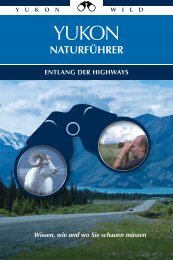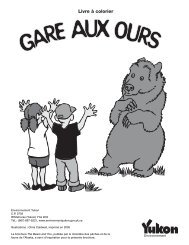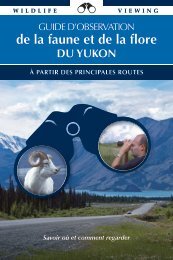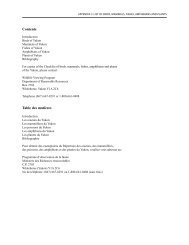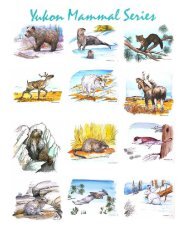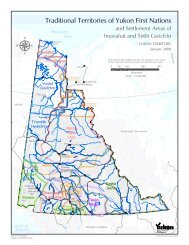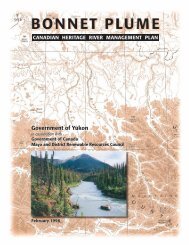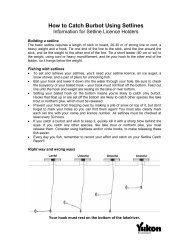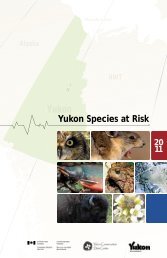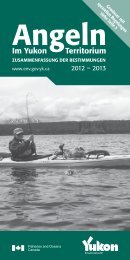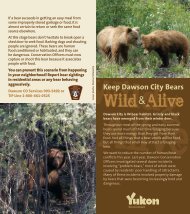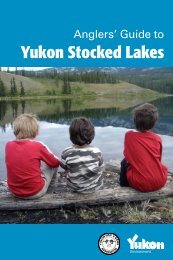Ch. 3 Land - Environment Yukon
Ch. 3 Land - Environment Yukon
Ch. 3 Land - Environment Yukon
You also want an ePaper? Increase the reach of your titles
YUMPU automatically turns print PDFs into web optimized ePapers that Google loves.
Northwest staging route, and an oil<br />
refinery were built during the 1940s, a<br />
war-time mentality prevailed. Speed<br />
was of the essence with all of these<br />
huge projects, and environmental<br />
considerations were often not taken<br />
into account. Little was known, for<br />
example, about the long-term effects of<br />
hydrocarbon wastes. An oil refinery<br />
was built in what is now known as the<br />
Marwell industrial area in Whitehorse.<br />
Though it only operated for a year, the<br />
refinery and the system of storage tanks<br />
and pipelines that went along with it<br />
left a trail of contamination behind<br />
them. Some sites, such as the Marwell<br />
tar pit, still have not been cleaned up.<br />
In the 1950s the Cold War brought<br />
another US military project to the<br />
north, the Distant Early Warning (DEW)<br />
Line. This system was built to detect<br />
Russian long-range bombers. It was<br />
also the era when PCBs and other<br />
hazardous substances were in<br />
widespread use. PCB-laced paint was<br />
used at the three DEW Line stations<br />
built on the <strong>Yukon</strong>’s North Coast,<br />
which are all slated for clean-up.<br />
For more than two decades, DDT was<br />
used to control mosquitoes in the<br />
<strong>Yukon</strong>. Starting in the 1940s, DDT was<br />
sprayed from airplanes over lakes and<br />
rivers, roadways, pipelines and<br />
communities. Cans of DDT were<br />
abandoned at Rainy Hollow, a former<br />
pumping station in British Columbia,<br />
just across the <strong>Yukon</strong> border. Brooks<br />
Brook on Teslin Lake, a former military<br />
site, was also heavily contaminated<br />
with DDT. These two sites were<br />
cleaned up by the federal government<br />
at great expense.<br />
Thousands of American soldiers and<br />
civilians came to the <strong>Yukon</strong> to work<br />
on these megaprojects, and their arrival<br />
created a garbage problem in the<br />
<strong>Yukon</strong>. The approach used for<br />
disposing trash in Whitehorse was<br />
typical for that era. The American army<br />
opened a dump by a cliff off Range<br />
Road, near the confluence of McIntyre<br />
Creek and the <strong>Yukon</strong> River. Debris was<br />
regularly pushed over the edge into<br />
the <strong>Yukon</strong> River 2.<br />
“Before 1939, they were dumping<br />
all the garbage in the channels<br />
of the <strong>Yukon</strong> River right where<br />
Sophie Slim used to live (near<br />
Kishwoot Island) in downtown<br />
Whitehorse.”<br />
– Paddy Jim, <strong>Ch</strong>ampagne and<br />
Aishihik First Nation Elder<br />
Paddy Jim<br />
The Range Road dump was closed in<br />
1975, and tests have shown that<br />
leachate from this dump now has only<br />
a minor impact on groundwater at the<br />
dump site and no measurable impact<br />
on the quality of <strong>Yukon</strong> River water. But<br />
First Nations and other residents downstream<br />
of the dump are still concerned<br />
about lingering contamination. Tests<br />
of sediment cores taken from Lake<br />
Laberge, downstream of the dump,<br />
indicate that a spill of polychlorinated<br />
biphenyl (PCB) occurred sometime in<br />
the 1950s. This may or may not be<br />
associated with the Range Road dump.<br />
In 1976 the City of Whitehorse tried a<br />
new disposal method. It began burning<br />
its garbage and putting the residue in<br />
the War Eagle Pit, an abandoned<br />
quarry pit located near the current<br />
Whitehorse landfill. Waste oil was<br />
disposed of in one part of the pit, a<br />
practice that continued until 1995.<br />
After 10 years, concerns about groundwater<br />
contamination led to the opening<br />
of the Son of War Eagle Pit, the<br />
territory’s first sanitary landfill.<br />
<strong>Land</strong>filling, or covering garbage with<br />
dirt, is an expensive way to dispose of<br />
trash, and the city is still working on<br />
ways to reduce the amount of waste<br />
that goes into the pit.<br />
What is so special about Special<br />
Waste?<br />
The main problem with solid waste is<br />
that it takes up space, and even in a<br />
land as vast as the <strong>Yukon</strong>, finding<br />
locations for new dumps can be a<br />
problem. Special waste, on the other<br />
hand, requires special handling. It<br />
cannot just be thrown into the dump.<br />
Special wastes include dangerous<br />
goods that are no longer used for their<br />
original purposes, and can take any<br />
form from a solid to a gas. Waste oil<br />
and biomedical waste are two<br />
examples of special wastes. Common<br />
special wastes in homes and businesses<br />
include waste oil, solvents, petroleum<br />
products, unused household cleaners,<br />
paints and pesticides. This unwanted<br />
material presents a serious real or<br />
potential hazard to health, safety, and<br />
the environment. Permits are required<br />
for handling various quantities of special<br />
waste.<br />
No exact figures are available on the<br />
amount of special waste generated<br />
Special waste can be:<br />
• flammable<br />
• corrosive<br />
• toxic<br />
• infectious<br />
•explosive<br />
•radioactive<br />
• persistent<br />
5 2 ❧ Y U K O N S T A T E O F T H E E N V I R O N M E N T R E P O R T 1999





